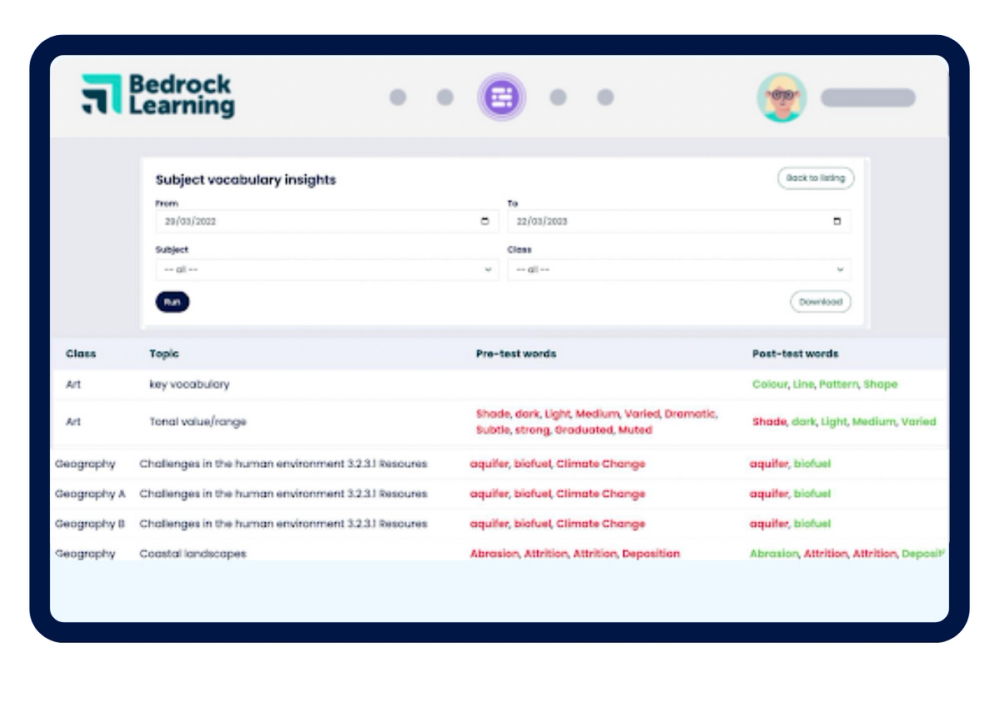In recent blogs, we’ve discussed the challenges that schools face surrounding quality vocabulary instruction at scale and the ways in which the vocabulary instruction in our platform has cognitive science at its heart.
Vocabulary instruction at scale
I remember the first time I heard of Bedrock: I was a new subject lead in a school where learners often arrived with a vocabulary deficit. I felt as if I needed a solution to serve quality vocabulary instruction to learners at scale that didn’t rely solely on my English curriculum of reading during library times (crucial though those things are).
Inspired by Robert Marzano, our approach provides all learners with a bespoke, sequenced pathway which supports academic vocabulary acquisition.
Domain Specificity
In his own words, Bedrock’s founder, Aaron Leary, created Mapper because:
“I've never come across a learner with a masterful command of subject-specific vocabulary who did not also attain high grades in those subjects. This insight inspired the creation of Mapper. When hundreds of Bedrock teachers attended my webinar on integrating Tier 3 vocabulary into their subjects on the Bedrock platform, it signalled its potential for transformative educational impact. Thus, we forged ahead and built a solution of 45,000 Tier 3 words across every department!”
I’ve written before about my views on the need to shift our understanding away from vocabulary and towards concepts.
Ferdinand de Saussure - a Swiss linguist - made a simple (albeit brilliant) observation about language. He observed that in our minds, we have a collection of underlying concepts that language helps us to refer to and articulate. Bedrock’s Core supports learners to build their vocabularies to access the curriculum in its entirety, but, just for a moment, think about the concepts that underpin your subject.
In my recent podcast conversation with Kate Stockings, I gave a loose definition of Gross Domestic Product (they did not just give away GCSE Geography in 2002, you know), which, being a subject specialist, she pounced on. In the same way, I would not want to teach my learners about Scrooge and just say he was misanthropic without unpicking the root of the word and exploring the symbolism of this character with them.
My point is that, in some ways, the tier 2 and 3 distinction might have started to get in the way in some cases. A tier 2 word can acquire tier 3 significance when it comes to subject understanding. Around a dinner table of adults, or whilst watching the news, GDP or ‘misanthropic’ as tier 2 academic words may serve us well, but as subject specialists, we need more.
Unlocking potential: why our learners need Mapper
It’s great that vocabulary is a part of our conversation now; schemes of work have vocabulary lists and we have knowledge organisers as part of the furniture now. Although we need to be cautionary with implementation, we’re moving in the right direction.
Let’s agree on three things:
- There are key concepts that underpin our disciplines
- We need our learners to understand those key concepts
- Moving those key concepts from learners’ receptive to expressive vocabularies is an essential part of learning
As previously discussed, the human brain has a delicate relationship between working and long-term memory.
Consider a typical scheme of work that a teacher might use to plan a lesson and reflect upon:
- Are the key concepts broken down with a shared definition?
- Is the sequencing and teaching of those concepts explicitly shared?
- Are teachers expected to teach these shared concepts and supplement them with their own?
- How do we check for understanding of these concepts whilst not over-burdening learners?
Now consider a typical knowledge organiser that a learner might be provided with:
- How often are pupils encouraged to use the concepts on the knowledge organiser from receptive to expressive?
- Are those concepts presented in a way that asks learners to consider their meaning from different angles (image, synonym/antonym, comprehension)?
- Are learners regularly tested on the meaning of the concept? If so, how often?
- Do you have a simple, rapid way of checking learners’ understanding of those concepts to understand patterns across the class and to identify underachievement?
When you’ve sequenced content on Mapper, learners will quickly begin a session with their recap questions, followed by the re-teaching of other concepts that they still need to work on. All the while, feedback is constantly being gathered and fed back to teachers and leaders about learners’ understanding.

A learners view of Bedrock Mapper
Mapper is the solution
Bedrock has been the solution to scalable tier 3 vocabulary sequencing for hundreds of thousands of learners, and we’re continuously gaining insights and impact data to demonstrate this.
Whether used as an in-class or home learning tool, with Mapper, you’re able to select from our curriculum-aligned content - all of which has the very best of Bedrock’s vocabulary instruction alongside it - and then have it taught to your learners at scale through short, twenty-minute sessions.
If they demonstrate that they understand the concept, then the algorithm will check in with their understanding later, but if they don’t, they will be re-taught the concept with our pupil-friendly definitions and activities. You are also given granular-level insights about learners’ understanding and misunderstanding!

The possibilities are incredible. At every conceivable level (learner, class, year, micro-population, school), you will receive insights in response to the following:
- What has been understood? What hasn’t?
- Where is underachievement happening? Which concepts are the root cause?
- What might we need to reteach?
- What might we need to replan?
These are all questions we answer daily as school leaders, but in doing so, we’re often forced to make inferences based on assessment data that is often a ‘one-time.’ Using Mapper gives you detailed, real-time, accurate answers to these questions.
Next Steps:
If you’re a Bedrock school, your learners have access to Mapper in at least one subject. If you’d simply like to dive in yourself, you can start here. If you’d like CPD and support with planning and implementation, please email us at education@bedrocklearning.org.
I would follow these golden rules:
- Less is more: despite the temptation (because there is so much quality content inside of Mapper), try to sequence no more than 15-20 words per topic. It would be an excellent idea to think of these words as the core knowledge of the topic; discuss and collaborate with colleagues about the choice of these words.
- Share the sequencing across classes so that the core knowledge is available to every teacher and every learner.
- Encourage colleagues to supplement the word list with their own choices depending on their classes- making this truly personal.
- Use the subject-insight report at class and year group level to identify your teaching opportunities and forward planning.
Our Teaching and Learning Team love talking to all subjects about Mapper- so please do feel free to reach out and book some time with us to discuss any of this.
We believe it’s amazing, and we know you will too!






